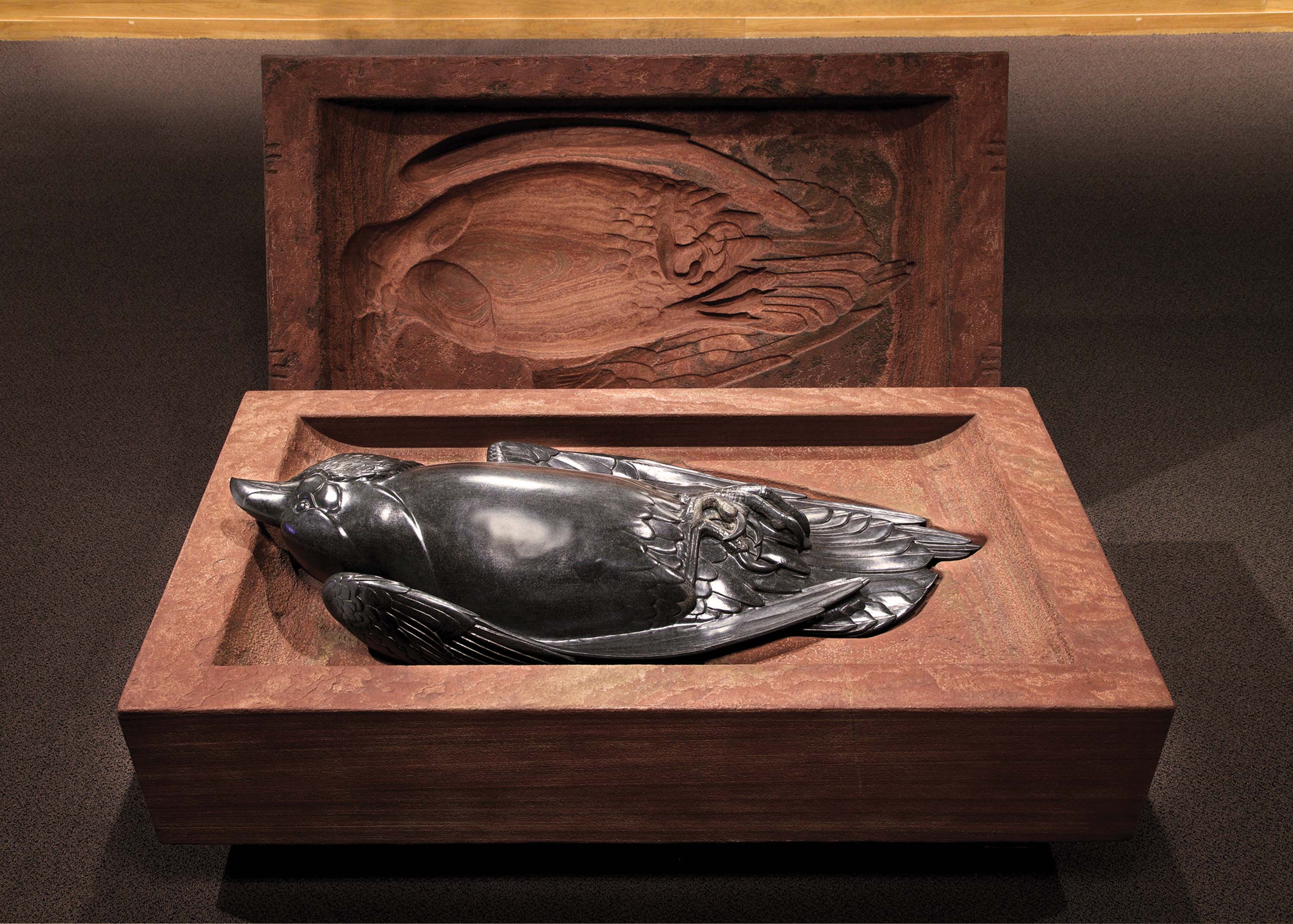
06 Mar Kestrel Flies High
ETRUSCANS. ASSYRIANS. ABORIGINAL ANIMISTS. Greeks. Romans. Egyptians. Chinese. Cherished, though their works are today as objects of cultural antiquity, artisan stone carvers created imagery that spoke to their contemporary times, yielding insight into the core values of civilizations.
One hundred years from now, who will be the visionaries remembered for having had the courage to say something authentic and real about the American West?
There is nothing pretentious, tentative or static about Steve Kestrel. Soft-spoken, yes, as well as introverted, bookish, self-effacing, somewhat elusive and covetous of solitude in his native region, Kestrel does not beat his own different drum. His work — recognizable, distinctive and multidimensional — is seizing public notice as never before.
“In my opinion, Steve Kestrel is a national treasure. As a museum curator and an art dealer I have admired Steve’s work for almost 25 years,” says Maria Hajic, who has helped build the Gerald Peters Gallery in Santa Fe into a hub for collectible wildlife art.
“His vision is truly unique,” she adds. “I can think of no other living sculptor who captures both the beauty and the mystery of his chosen subject. His work continually seeks a deeper connection to the natural world. His forms appear timeless and sleekly modern at the same time.”
In 2013, Kestrel’s stone sculpture, Desert Timeline, portraying a rattlesnake winding through stone and time, won the coveted Prix de West Purchase Award at the National Cowboy & Western Heritage Museum’s annual art show in Oklahoma City. He’s been a multiple gold-medal winner at The West Select exhibition at the Phoenix Art Museum, was the featured artist at the Coors Western Art Exhibit & Sale in Denver, and has watched the number of museums holding his work in their collections grow to more than a dozen.
Emanating from Kestrel’s soul is a concern for our planet — the only one of its kind, cradling incredible diversity. Kestrel does not preach or rant or make art that serves as a fulcrum for personal moralizing. He wants nature to reverberate across human consciousness and it’s why his pieces command attention.
“Steve is not afraid to create work that comments on man’s damaging effects on our natural resources,” Hajic says.
Kestrel lives with his wife, Cindi, and their dogs and cats on 43 acres in a glorious canyon along Redstone Creek, tucked into the foothills west of Fort Collins, Colorado. At first blush, there are few hints of exactly how hardwired Kestrel is to Earth’s humbling elemental forces.
In 2013, on a mid-September day that is normally quiet and mild, unseasonable torrential rains carried north from the Gulf of Mexico and across the desert Southwest bore down upon the Rockies delivering a flash flood. A wall of water thundered down Redstone, chiseling through ancient sandstone. Ironically, it also deposited, literally in the Kestrels’ backyard, another motherlode of colorful, brilliantly striated and smooth-tumbled boulders that Kestrel is transforming into new works.
The deeper one delves with the chisel beyond the surface, the more the artist must adapt and improvise, letting unique revelatory features of the rock serve as a guide. Creativity and the stone’s own personality become one.
Direct carving is an unforgiving reductive process. Does it extend in the same way to Kestrel’s approach to sculpture in general? “Yes,” he says. “It’s called editing. Leaving out things I originally had in mind but once analyzed are considered excessive, is a part of it. I’ve gained more confidence to do that with age.”
A poignant example is Kestrel’s new avian work, Fragile/ Poorwill, born from an obtuse-shaped riverstone with two large cracks which he simply incorporated into the design.
That Kestrel is known for working in found materials (in this case some of the oldest kinds of rock on Earth) and brilliantly transforming them using the direct-carving method is an understatement. Kestrel’s stone pieces in the past have created a commotion, but it was a conceptual sculpture composition in slate and sandstone that won him the 2013 Prix de West Purchase Award and asserted his standing.
“Steve’s recognition at Prix de West in 2013 reminded me of the Cowboy Museum’s deep roots in the wonderful myths and harsh realities of our American West,” says Bill Kerr, who was among the first to recognize, decades ago, the importance of Kestrel’s work. Today, the National Museum of Wildlife Art, which Kerr co-founded, has 15 Kestrel carvings and bronzes in its permanent collection. “You just have to love an artist that was born close to the Rio Grande and has chosen to work with the most rugged of authentically Western materials.”
Mike Leslie, assistant director of the National Cowboy & Western Heritage Museum, sees an architectural quality in Kestrel’s work. “He hasn’t ventured too far afield from the iconic imagery that flowed out of the Art Deco and Art Nouveau movements that championed a dynamic integration between structure and form,” Leslie says. “But he brings a thoroughly modern perspective. There’s something about his work that is provocative and imaginative and causes you to think about more than just the immediately aesthetic beauty of his pieces. They invite you to ponder bigger questions.”
After Kestrel’s triumph at Prix de West, the artist escaped to the wilderness on an 86-mile, weeklong rafting trip down the Green River through Desolation and Gray canyons, famously boated by John Wesley Powell. “It was a spectacular trip, and included some professionals in the fields of geology, botany and general ecology,” he says, describing a drive across rugged backroads to reach the put-in point. On the way in, Kestrel says, the genesis of his next sculpture project, a provocative piece called Fracking, entered his mind.
Fracking, which took four intense months to complete, is a complicated composition and a piece that some are calling a masterwork. Weighing 6,000 pounds and melding Colorado sandstone with black slate, bronze and steel, it won Kestrel a gold medal — the third year in a row — from the Phoenix Art Museum’s annual show, The West Select.
Kestrel has thought a lot about the toll being paid for America striving toward energy independence. That’s not a bad thing, but it comes with incredible costs in the form of pollution linked to climate change. He has stood before the “shock and awe” of landscape destruction. And he sympathizes with millions of people living in close proximity to the energy boom who always worry about potentially harmful subterranean impacts.
“To represent horizontal drilling and fracking, I have used the rattlesnake as a very appropriate metaphor,” he says. “It is secretive and winters underground in unknown crevasses and caverns; it usually gives a warning signal, but if ignored its venomous bite results in injury or death. Being a pit-viper, it ‘sees in the dark’ within the infrared band; it can’t hear and it always has its eyes open.”
The artist’s role is not to kowtow, not to deliver to collectors what they expect or want; it is to usher them forward by first inspiring reflection. Kestrel does not “make cute” with his subjects, says Jerry Smith, curator at the Phoenix Art Museum. He says Fracking, which made its debut at the West Select, is “by far the most powerful image I’ve seen that speaks to the rather controversial energy extraction process.”
“Kestrel is able to explore the rhymes and rhythms of nature through his wildlife motifs,” he says. “The work is more than just a depiction of an animal or bird or reptile. It speaks to the fact [that] we share the planet with beings that aren’t just human. He doesn’t put the animal in a human context. He puts it in an art context that expands into something broader.”
Kestrel credits three legendary artists with affecting something even more important than his style — a working philosophy. They include Georgia O’Keeffe [1887–1986], Boris Gilbertson [1907–1982] and American sculptor and painter, George Carlson.
During his youth, Kestrel was restless. He attended Colorado State University in Fort Collins for a few years, thinking he would get a degree in fine art, but left out of frustration. In the early 1970s, he road-tripped to southern California, spent time in Arizona auditing art history classes and then visited his childhood home in Alamogordo, New Mexico, in the Chihuahuan Desert. He got a wild idea: Pay a visit to Georgia O’Keeffe in Abiquiu.
After initially being turned away brusquely on her doorstep, (O’Keeffe had just returned from an important exhibition in San Francisco), Kestrel didn’t give up. “Here I was a young guy who had made the effort to seek her out, just to have a conversation about art,” he says. “After leaving and some reflection, I returned a few hours later, and she was much more welcoming. She then invited me in and graciously asked me to join her for dinner.”
He found that O’Keeffe, on this occasion, wasn’t the prickly person portrayed in history books and the lectures delivered by his professors. She was accessible and willing to discuss her work. Critics asserted, for example, that O’Keeffe’s flower series were intended to be erotic and an explanation of feminine sexuality. O’Keeffe told Kestrel she had merely set out to explore the flower’s sensuous forms and wonderful colors for their own sake. She also said that whatever her subject matter, it would never obscure the importance of form and color in her paintings.
Gilbertson, meanwhile, became a dear friend when Steve and Cindi Kestrel were living in Santa Fe. Gilbertson completed a number of bas-relief carvings, a few of which adorn the U.S. Interior Department building in Washington, D.C., and other public edifices commissioned through the Works Progress Administration programs during the Great Depression. Gilbertson’s partner, Charlotte White, gave Kestrel the air hammers he used over the course of his career.
Gilbertson’s advice to Kestrel was similar to that imparted by Carlson: Search for the inner rhythms of subjects. “I always feel, after coming in contact with Steve’s creations, that he has one foot planted in the ancient world and the other in the here-and-now,” two-time Prix de West winner Carlson offers. “Steve’s creations have a primordial ooze about them. They can be so spare, but in that simplicity is a high level of sophistication and impact.”
If you are not striving to seek the truth, Kestrel says, then you are involved in a deception. Art is not a sedative. Nor is it subterfuge or a farce, which spares the viewer from confronting difficult, sometimes uncomfortable questions.
“I revel in the mysteries of nature, but I also look for explanations from science,” Kestrel says, noting that, by coincidence two prominent university climate researchers studying this phenomenon at both poles live up the road in Redstone Canyon. “My private conversations with the very people who collect the data and have seen the effects of climate change for the last 25 to 30 years, are extremely compelling.”
“The earth is not flat and the sun does not revolve around our planet. It’s time for some real introspection and dealing with reality,” he adds. “You hear it all the time, that we artists are making things that ‘celebrate wildlife.’ Celebration is good. But how can you do that and stand around while pieces of our natural system are unraveling and going down in flames?”
Kestrel does not preach or rant or make art that serves as a totem of personal moralizing. He wants nature to reverberate across human consciousness. “At some point your work has to stand for something — at least I hope my work does,” he says. “I would be happy if my art, in some small way, opened hearts and minds. If enough people become aware and concerned, positive things can happen.”
At least that’s the way Kestrel sees it. And it’s why his compositions are being acquired by museums. But that’s not to imply that his body of work isn’t at once provocative and, like biodiversity itself, comprised of beautiful dazzling forms.
It’s impossible to single out one piece that conveys what Kestrel is after, but a lecture about art history could commence with Silent Messenger from the National Museum of Wildlife Art collection. The large work portrays a 5-foot-long raven carved in black Wyoming granite that, in turn, is encased in a symbolic open sarcophagus of red sandstone. The mythological bird, known for its intelligence and regarded by many native tribes as a deity, conveys a warning about humankind’s treatment of nature. The human handprints, subtly carved into the freestanding sarcophagus lid, suggest that we may be responsible for sealing in or freeing the life forces of nature.
Bill Rey of Claggett/Rey Gallery in Vail, Colorado, says Kestrel’s work is avidly purchased by some of the most discriminating private collectors in America. “Steve wears his creative truth on his sleeve. I’ve followed his work for 30 years and no two pieces are alike. I’m not worried that he doesn’t soften his narratives to suit the whims of a sometimes fickle art market because, frankly, his honesty is what people love and respect about him. You want to reach out and touch his work like you do a religious artifact,” Rey says. “He is making a statement about the times he’s living in and when he’s long gone, the power of his work will be that much stronger. I don’t say this very often about artists, but Kestrel is in a league of his own.”
These days, Kestrel says he thinks about carving “within the context of fragility, taking the longer view, pondering our place in the universe. “Our ‘third rock from the sun’ should not be blithely carved up by 7 billion of us into something unrecognizable,” he says.
Kestrel does not shy away from making art that reflects mankind’s negative impact on our natural resources, Hajic says, “which can be problematic to an artist’s career.” Hajic adds that Kestrel’s work appeals especially to intelligent collectors who want more than mere superficial experience with art. They admire his utter creative fearlessness.
“Has Steve finally begun to receive the recognition he deserves? The art world is still catching up to his vision. Prix de West was a beginning. There is so much soulless art and, in contrast, Steve’s carvings and sculpture have such heart. As our awareness of nature evolves, so will our appreciation for his incredible body of work.”
- “Fragile/Poorwill” | Colorado Riverstone | 5.25 x 11.5 x 9.25 inches | 2014
- “Desert Timeline” | Black Slate and Colorado Sandstone | 9.5 x 31.75 x 7 inches
- Kestrel with “Circle of Cranes” | Bronze and Stone | 72 x 28 x 10 inches (edition of 8)
- The creation of “Fragile/Poorwill”
- The creation of “Fragile/Poorwill”






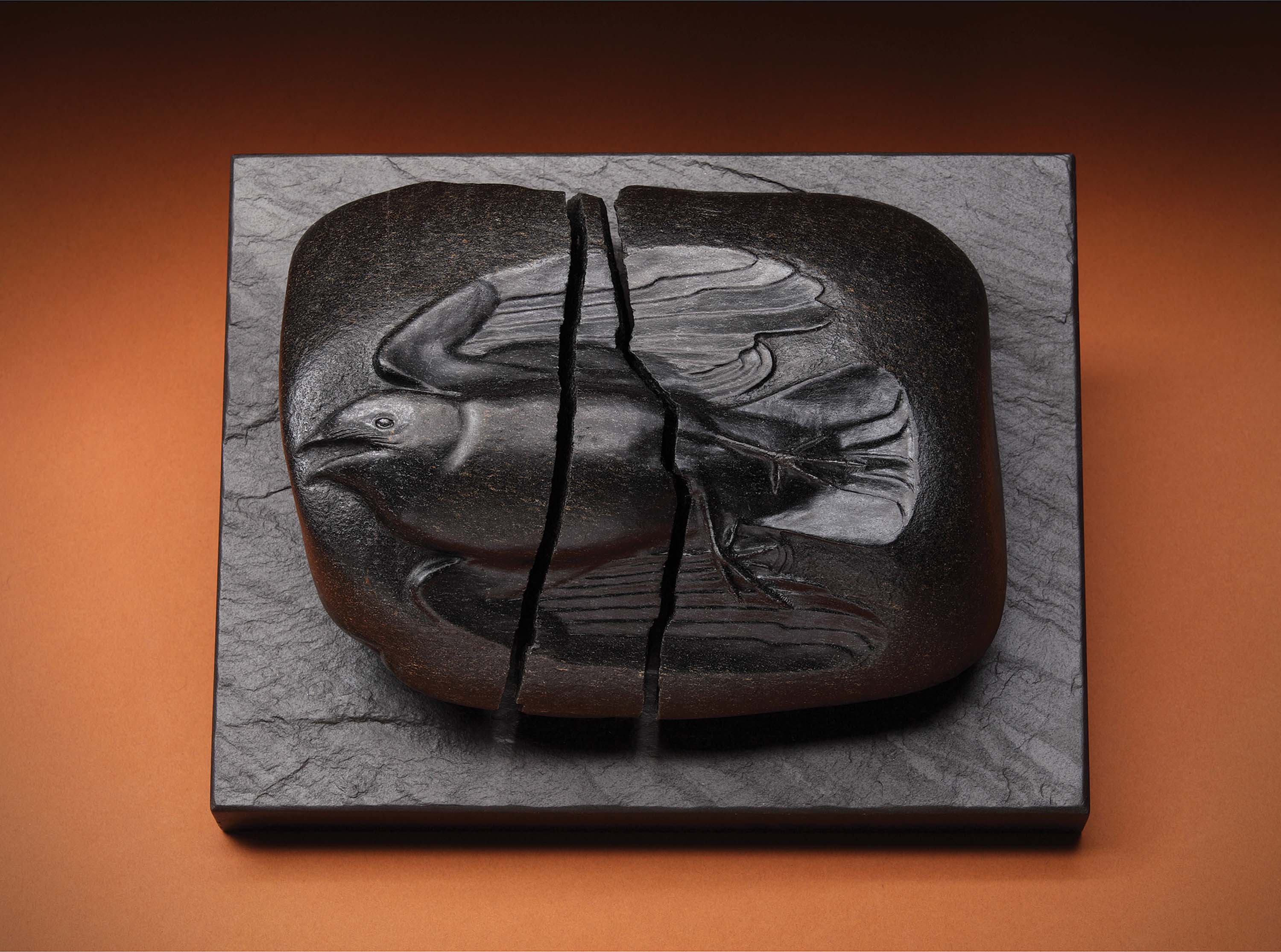
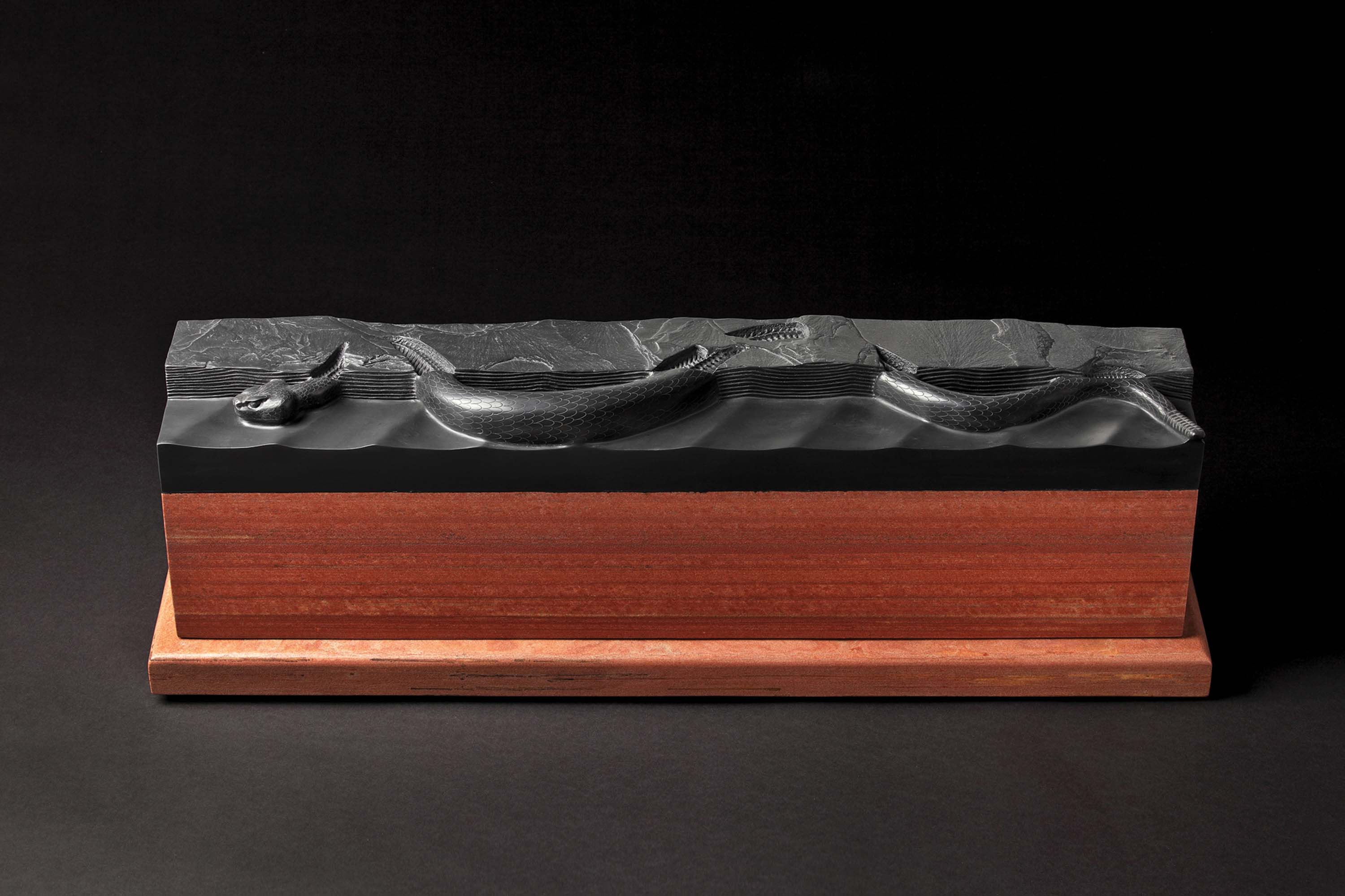
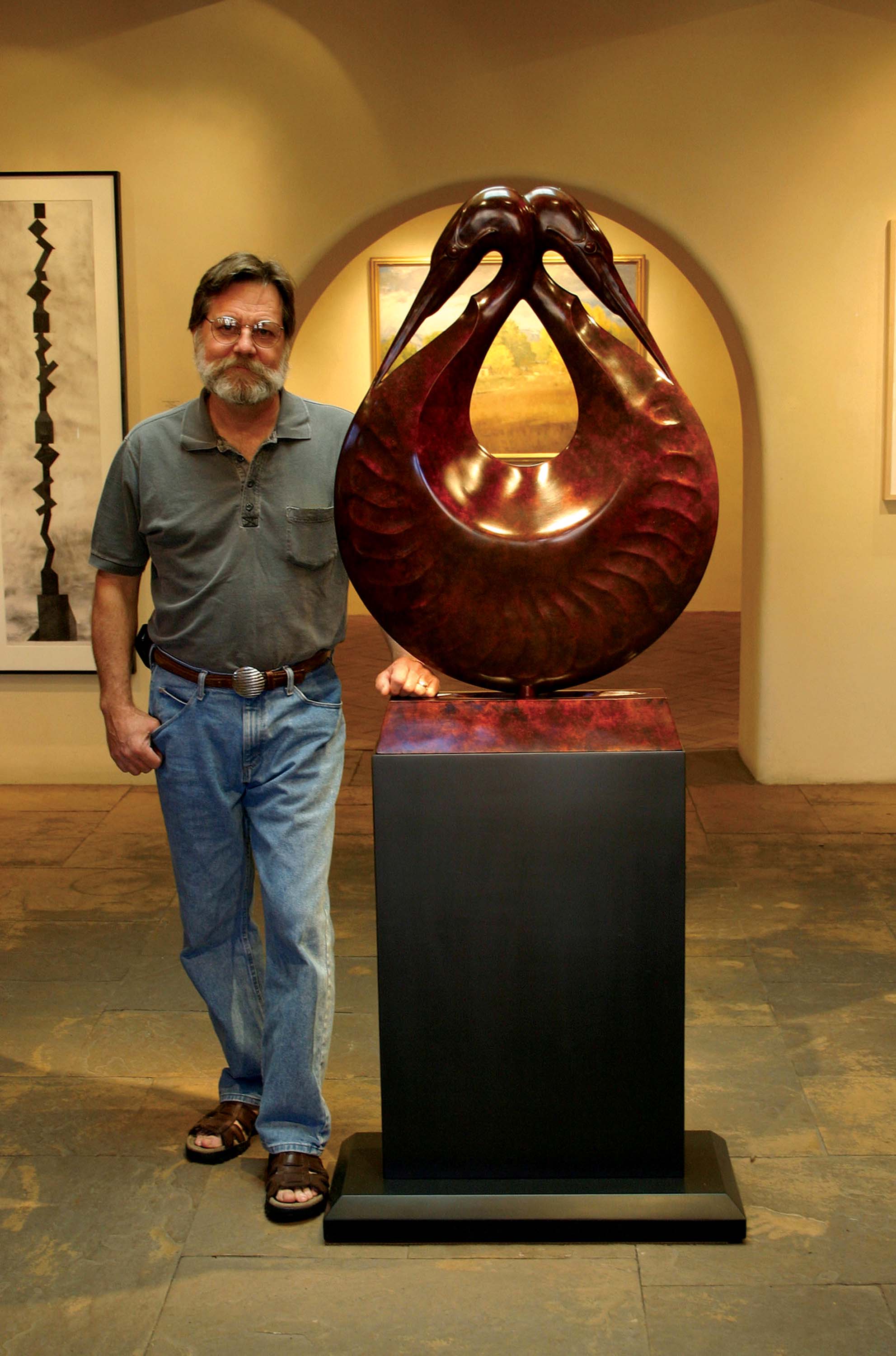

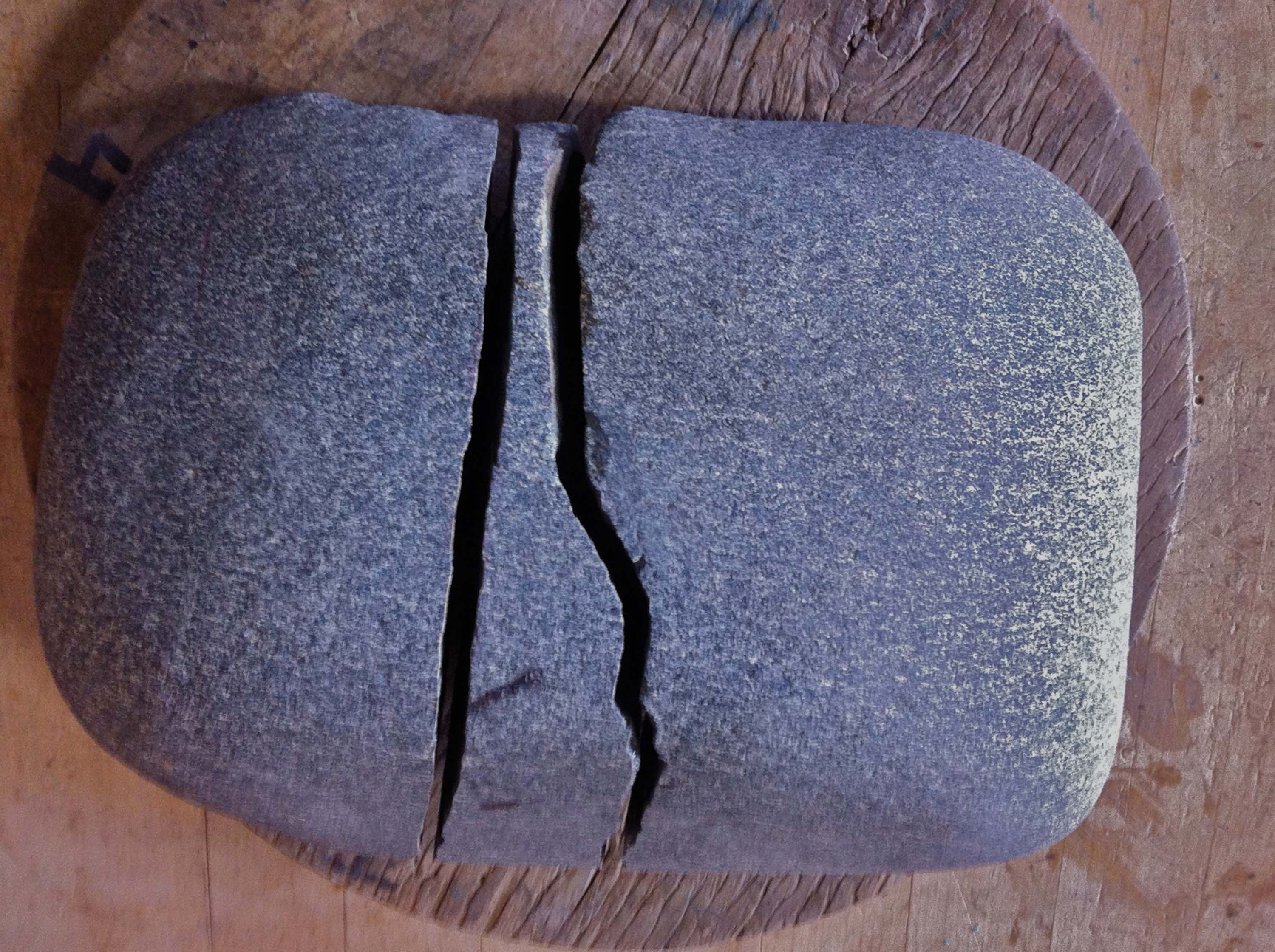

No Comments